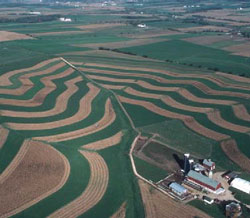 A new USDA study shows that farmers using combinations of erosion-control and nutrient-management practices on cultivated cropland are reducing losses of sediment, nitrogen and phosphorous from farm fields and decreasing the movement of these materials to the Great Lakes and their associated waterways.
A new USDA study shows that farmers using combinations of erosion-control and nutrient-management practices on cultivated cropland are reducing losses of sediment, nitrogen and phosphorous from farm fields and decreasing the movement of these materials to the Great Lakes and their associated waterways.
“The Great Lakes Conservation Effects Assessment Project (CEAP) study confirms that good conservation planning and implementation have reduced loadings of sediment and nutrients to waterways throughout the region,” Agriculture Secretary Tom Vilsack said. “The Administration appreciates the actions of every farmer who is stepping up to implement conservation practices, protect vital farmlands and strengthen local economies. At the same time, we also see opportunities for even further progress.”
 The CEAP study, prepared by USDA’s Natural Resources Conservation Service (NRCS), estimates that the use of conservation tillage and other conservation practices has resulted in a 50 percent decline in sediment entering rivers and streams, along with 36 and 37 percent declines, respectively, in phosphorus and nitrogen loading.
The CEAP study, prepared by USDA’s Natural Resources Conservation Service (NRCS), estimates that the use of conservation tillage and other conservation practices has resulted in a 50 percent decline in sediment entering rivers and streams, along with 36 and 37 percent declines, respectively, in phosphorus and nitrogen loading.
USDA-NRCS Chief Dave White outlined four major conclusions from the study. “First is that conservation works. Second, we also know that more needs to be done and primarily in this region that is nutrient management, particularly sub-surface nitrogen and phosphorus,” he said. “Third is that systems of conservation practices work best. And the fourth takeaway is that we can have a much greater impact with our programs if we target our resources to those acres where the need is greatest.”
The study covers nearly 174,000 square miles – the entire U.S. side of the Great Lakes Region – including nearly all of Michigan and parts of Illinois, Indiana, Minnesota, New York, Ohio, Pennsylvania and Wisconsin.
The Conservation Technology Information Center Conservation in Action Tour this year took place in the northwest Ohio region of the Lake Erie watershed and we got some interesting insight from state NRCS staff in that area.
